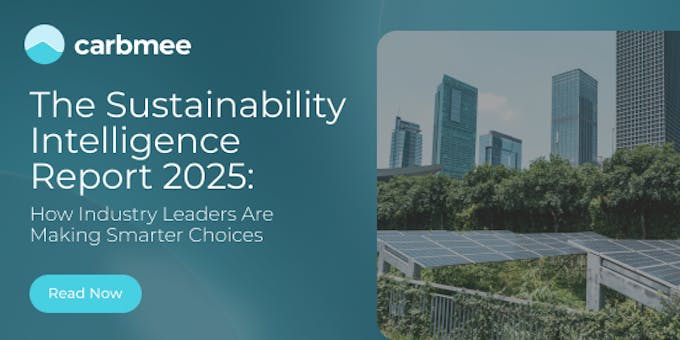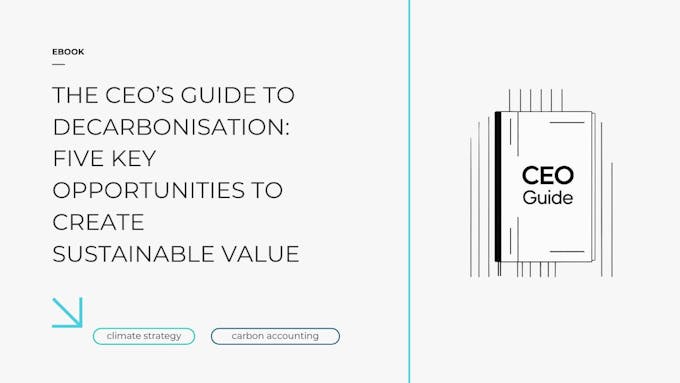Introduction
Reducing Scope 3 emissions, the largest and most challenging portion of a company’s carbon footprint, is essential for meeting climate goals and regulatory standards. These emissions result from indirect activities in a company’s value chain, from supplier practices and transportation to end-of-life product disposal. While indirect, Scope 3 emissions often represent over 80% of a company’s total emissions, underscoring the need for comprehensive strategies to address them. In this guide, we’ll cover effective ways to reduce Scope 3 emissions, focusing on collaborative practices, technology solutions, and the role of data transparency. Carbmee’s platform supports companies in navigating these complexities with data-driven insights and actionable tools for meaningful reductions.
1. Partnering with Sustainable Suppliers
Suppliers play a significant role in the emissions of products and services. By actively selecting and partnering with suppliers who commit to sustainable practices, companies can achieve reductions throughout the value chain. Dual sourcing with sustainability as a criterion—choosing suppliers that prioritize lower emissions materials or use renewable energy—is an impactful step. It’s also important to incentivize suppliers to implement greener processes, providing financial or operational support where feasible.
Through Carbmee’s supplier engagement tools, companies can assess and track their suppliers’ sustainability efforts, gaining transparency into emissions data across multiple tiers. These insights allow businesses to make informed sourcing decisions that align with their emissions reduction goals.
2. Optimizing Logistics and Transportation
Transportation and logistics contribute significantly to Scope 3 emissions, particularly in global supply chains. Strategies like reducing travel distances, optimizing routing, and increasing load efficiency can have an immediate impact on emissions. Companies can also transition to low-emission transport options, such as electric vehicles or rail over road, wherever possible.
Carbmee’s platform provides data-driven insights to optimize logistics, including emission tracking for each mode of transportation. By analyzing routes and freight methods, businesses can make strategic adjustments that reduce emissions without sacrificing efficiency.
To learn more, see our article on The Role of Technology in Scope 3 Emissions Tracking and Transparency.
3. Implementing Circular Economy Practices
A circular economy approach minimizes waste by reusing materials and recycling products at the end of their lifecycle. Companies can adopt circular design principles, aiming to reduce emissions by creating products that are easier to recycle, remanufacture, or repurpose. This approach can significantly reduce downstream emissions in categories like end-of-life treatment of sold products.
Carbmee supports circular economy practices with tools for carbon accounting and lifecycle assessment, helping companies track emissions reductions associated with recycling and material reuse. By using our platform, businesses can see the environmental benefits of circular practices reflected in their Scope 3 emissions inventory.
4. Focusing on Product Design for Emissions Reduction
Designing products with sustainability in mind—such as selecting low-carbon materials or reducing energy-intensive processes—can be a powerful lever for Scope 3 emissions reduction. For instance, companies in the apparel industry can shift from synthetic to natural, sustainable materials, while electronics manufacturers may focus on more energy-efficient components.
Carbmee’s lifecycle analysis tools enable companies to assess the emissions impact of materials and design choices, making it easier to identify sustainable alternatives during product development. By designing with emissions reduction as a key objective, businesses can make long-term changes that significantly cut Scope 3 emissions.
5. Encouraging End-User Sustainability
Downstream Scope 3 emissions, such as those associated with the use and disposal of products, can be managed by encouraging sustainable practices among customers. For example, companies in the electronics sector can provide guidance on energy-efficient usage, or packaging companies can offer recycling programs to reduce waste.
Through Carbmee’s comprehensive data solutions, companies can monitor and analyze downstream emissions trends, enabling them to develop targeted sustainability initiatives for customers. By guiding end-users toward more sustainable practices, businesses can support emissions reduction across the product lifecycle.
6. Leveraging Technology for Real-Time Tracking and Optimization
Technology plays a vital role in Scope 3 emissions reduction, from IoT-enabled sensors that provide real-time data to AI-driven insights that identify emissions hotspots. Advanced technologies allow companies to gather granular data across complex supply chains, which is essential for identifying and optimizing emissions sources effectively.
Carbmee’s platform integrates these technologies into an easy-to-use system that automates emissions tracking and provides actionable insights. Our tools allow businesses to continuously monitor and adjust their strategies, ensuring long-term progress in reducing Scope 3 emissions.
For more details, check out Challenges and Solutions for Accurate Scope 3 Emissions Measurement.
The Benefits of Reducing Scope 3 Emissions
Reducing Scope 3 emissions delivers both environmental and financial benefits. Effective management of Scope 3 can lead to lower operational costs through energy savings and supply chain efficiencies, while also boosting brand reputation by aligning with consumer demand for eco-conscious products. Additionally, regulatory compliance in regions like the EU can be more easily achieved with clear, transparent data on Scope 3 emissions, safeguarding companies from potential penalties.
Carbmee’s data-driven platform enables businesses to achieve these benefits by providing a comprehensive solution for emissions tracking, management, and reporting. Our technology empowers companies to make informed decisions that align with their sustainability goals, contributing to a greener, more resilient business model.
For a comprehensive understanding of Scope 3 emissions, including strategies for measuring, managing, and reducing your supply chain’s carbon footprint, check out our Ultimate Guide to Scope 3 Emissions: Measuring, Managing, and Reducing Supply Chain Carbon Footprints.
![[object Object]](https://images.prismic.io/carbmee/ZzsQz68jQArT09kR_HowtoReduceYourSupplyChain%E2%80%99sScope3EmissionsEffectively-3-.png?auto=format,compress)



